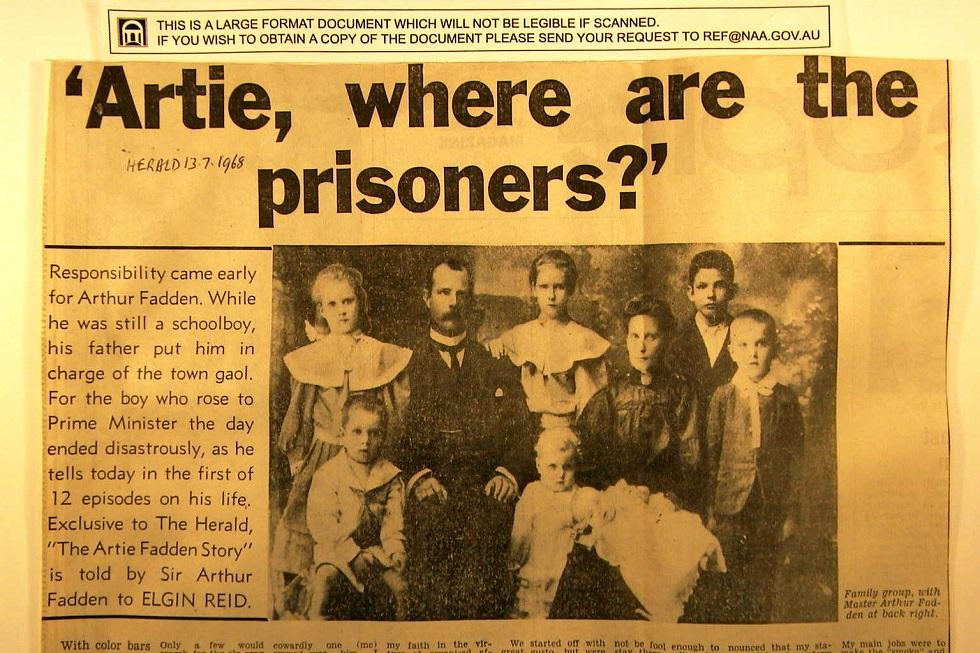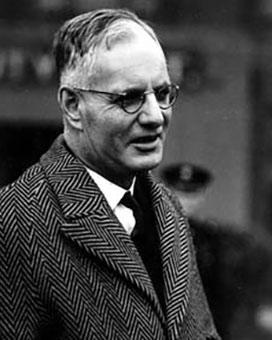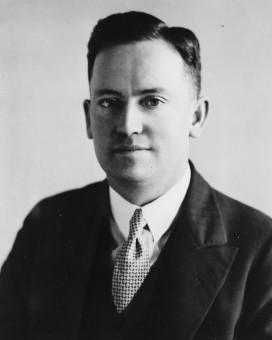Arthur William (Artie) Fadden was an alderman in Townsville in 1930 and a member of the Queensland parliament from 1932 to 1935. He entered the House of Representatives in 1936, holding the Darling Downs seat for 13 years, then the eastern part of the electorate which had become the seat of McPherson, for 8 years.
Fadden was Minister for Air and for Civil Aviation, then Treasurer, in the Menzies government in 1940–41. He became leader of the Country Party in March 1941, and Prime Minister when Robert Menzies lost office in August 1941.
Early years
Fadden was born on 13 April 1894, at Ingham in north Queensland. He was the eldest of the 10 children of Irish immigrants Richard and Annie (Moorhead) Fadden. After his father, a policeman, was posted to the small township of Walkerston near Mackay, Fadden went to the Walkerston school.

In this family photograph, published in a 1968 newspaper serialisation of his memoirs, Arthur Fadden was a schoolboy (standing on the right, behind his mother and younger brother). NAA: A5954, 62/1, p.20
In 1909, aged 15, he began work in the local canefields. He then found work as an office boy at the Pleystowe sugar mill. By April 1913, he worked as a clerk at the Mackay Town Council, and was involved in local cricket, Rugby Union and amateur theatre. Fadden’s skill with figures won him the post of Mackay Town Clerk in 1916. On 27 December that year, he and local milliner Ilma Thornber were married.
Queensland parliamentarian 1932–35
After qualifying through a correspondence course, Fadden set up an accountancy practice in Townsville in September 1918. He later established accountancy partnerships there and in Brisbane. In 1930, Fadden was elected to the Townsville City Council.
Fadden joined Queensland’s Country and Progressive National Party, and in 1932, was elected a member of the Queensland Legislative Assembly for the seat of Kennedy. In 1934, he was shadow Treasurer, but the following year was defeated after an electoral redistribution in Queensland. In March 1936, Fadden joined the rural group that split from Queensland’s combined Country and Progressive National Party. From then, Queensland maintained a separate Country Party, distinct from the United Australia Party.
Member for Darling Downs 1936
After the death of sitting member Littleton Groom on 19 November 1936, Fadden stood as the Country Party candidate in the 19 December by-election for the House of Representatives seat of Darling Downs. He defeated the United Australia Party candidate, and took his seat in a parliamentary session of only 29 sitting days in 1937. Fadden was again returned at the federal election on 23 October 1937 and a member of the 15th parliament, opened on 30 November by Governor-General Lord Gowrie.
This parliament was the third term of Prime Minister Joseph Lyons. As in his second term, he was dependent on the support of Country Party members. In the new parliament, his United Australia Party held 29 seats, the same number as the Labor Party led by John Curtin. Lyons’ Cabinet included five Country Party ministers, Earle Page as Minister for Commerce and Minister for Health, Harold Thorby as Defence Minister, John McEwen as Minister for the Interior, and Victor Thompson and Archie Cameron as ministers without portfolio.
Lyons’ leadership was under pressure both externally and internally. Keith Murdoch’s Melbourne Herald questioned his ability to hold the Cabinet together, and the resignation of Thomas White made a re-shuffle necessary on 7 November 1938. Then, when the government’s proposed national insurance scheme collapsed at a Cabinet meeting on 14 March 1939, Attorney-General Robert Menzies resigned from both Cabinet and the deputy leadership of the United Australia Party.
3 weeks later, Prime Minister Joseph Lyons died in office on 7 April 1939. Without a deputy, a United Australia Party leader was not immediately available as a successor, Country Party leader Earle Page became ‘caretaker’ Prime Minister. He had opposed Menzies’ resignation, seeing it as wrong at a time of political crisis in Europe and intended to provoke a leadership crisis. Page refused to enter into a coalition with a United Australia Party government that included Menzies, and made a bitter speech against him in parliament on 20 April. That same day, Page handed his resignation to Lord Gowrie, but remained in his ‘caretaker’ role until a new Prime Minister was commissioned.
Fadden and 3 other Country Party parliamentarians dissociated themselves from their leader and from the parliamentary party. In the next few days, Menzies was elected leader of the United Australia Party, and sworn in as Prime Minister on 26 April 1939. After Page resigned as Country Party leader in September, Archie Cameron replaced him, and Fadden and the others returned to the parliamentary party.
In March 1940, Prime Minister Robert Menzies reshuffled his Cabinet to form a coalition government with the Country Party. He included 5 Country Party members in the new ministry – Archie Cameron (Minister for Commerce and Minister for the Navy), HVC (Harold) Thorby (Postmaster-General and Minister for Health), John McEwen (Minister for External Affairs) and Arthur Fadden and Horace Nock (ministers without portfolio). As RG (Richard) Casey had resigned from parliament in January to become Australia’s Ambassador in Washington, only 3 United Australia Party members lost their places for the new Country Party ministers, (Sir) Eric Harrison, John Perkins and Harold Holt.
On 13 August 1940, 3 United Australia Party ministers were killed when their aeroplane crashed approaching Canberra. The loss of Geoffrey Street, James Fairbairn and Henry Gullet was a severe blow to the government, with a federal election on 21 September. Fadden himself was to have been on the flight, but instead the tragedy became his opportunity. He was sworn in to Fairbairn’s portfolios of Air and Civil Aviation the following day. He held the new portfolios in addition to his existing roles as minister assisting the Treasurer, and assistant Minister for Supply and Development.
After the federal election, Archie Cameron lost the Country Party leadership in a ballot in October 1940. The vote was evenly divided between Earle Page and John McEwen. The deputy leader, Fadden, was made acting leader to break the deadlock. On 28 October, he became Treasurer in Menzies’ Cabinet, replacing Percy Spender. The next day, Fadden became a member of the all-party Advisory War Council on 29 October 1940. He brought down his first budget the following month.

Deciphered cable from Prime Minister Robert Menzies in Egypt to acting Prime Minister Arthur Fadden on 27 April 1941, advising of the threat posed to Egypt by Germany's air power. NAA: CP2909/9, 17, p.20
Prime Minister Robert Menzies left for London on 24 January 1941, and Fadden was acting Prime Minister until May. During this time, Fadden was confirmed as leader of the parliamentary Country Party on 12 March 1941. He began moves to amalgamate Country Party and United Australia Party parliamentarians, but the Queensland Country Party strongly opposed this. Fadden also urged Labor leader John Curtin to consider a wartime all-party national government, but like Robert Menzies, he was unsuccessful.

Leader of the Opposition John Curtin moved to record the Advisory War Council's recognition of Arthur Fadden's role as acting Prime Minister and chairman of the council, 16 May 1941. NAA: A5954, 207/8, p.2
Menzies returned to Australia in May 1941 to a coalition deep in political intrigue. He was pressured both by his own party and his coalition partner to resign. On 28 August 1941, he did so. A joint United Australia Party–Country Party meeting chose Arthur Fadden as his successor, and Fadden was sworn in as Prime Minister the next day. The United Australia Party elected William Hughes to replace Menzies as party leader.
Sources
- Cribb, Margaret, ‘Sir Arthur William Fadden’, Australian Dictionary of Biography, Volume 14, Melbourne University Press, Melbourne, 1996.
- Fadden, Arthur, They Call Me Artie: The Memoirs of Sir Arthur Fadden, Jacaranda, Brisbane, 1969.
- Hughes, Colin, Mr Prime Minister: Australian Prime Ministers 1901–1972, Oxford University Press, Melbourne, 1976.
- Souter, Gavin, Acts of Parliament, Melbourne University Press, Melbourne, 1988.
From the National Archives of Australia collection
- Personal Correspondence – Australia. Rt Hon. Sir Arthur Fadden, 1962–1968, NAA: A5954, 62/1 (part)
- Advisory War Council. Appreciation of Mr Fadden’s Chairmanship, 16 May 1941, NAA: A5954, 207/8
- Cables from Mr Menzies to Acting Prime Minister Fadden, 1941, NAA: CP290/9, 13 and 15





